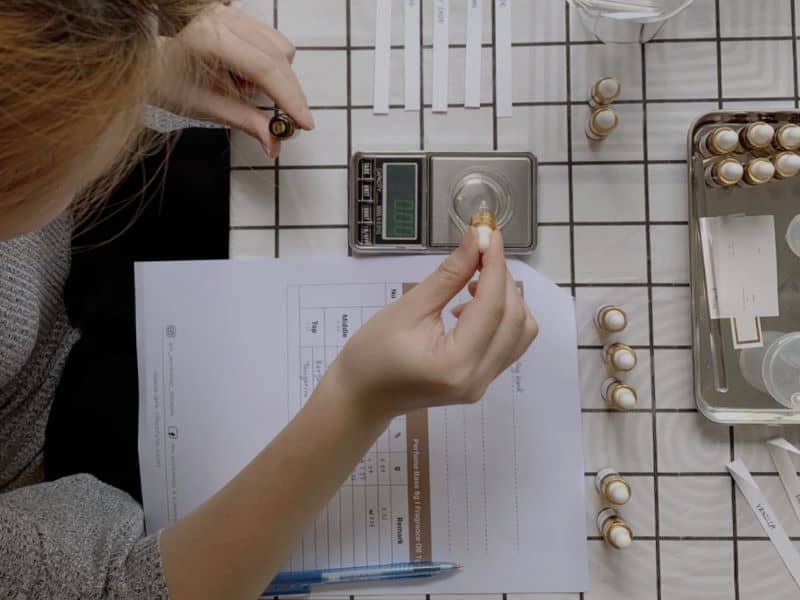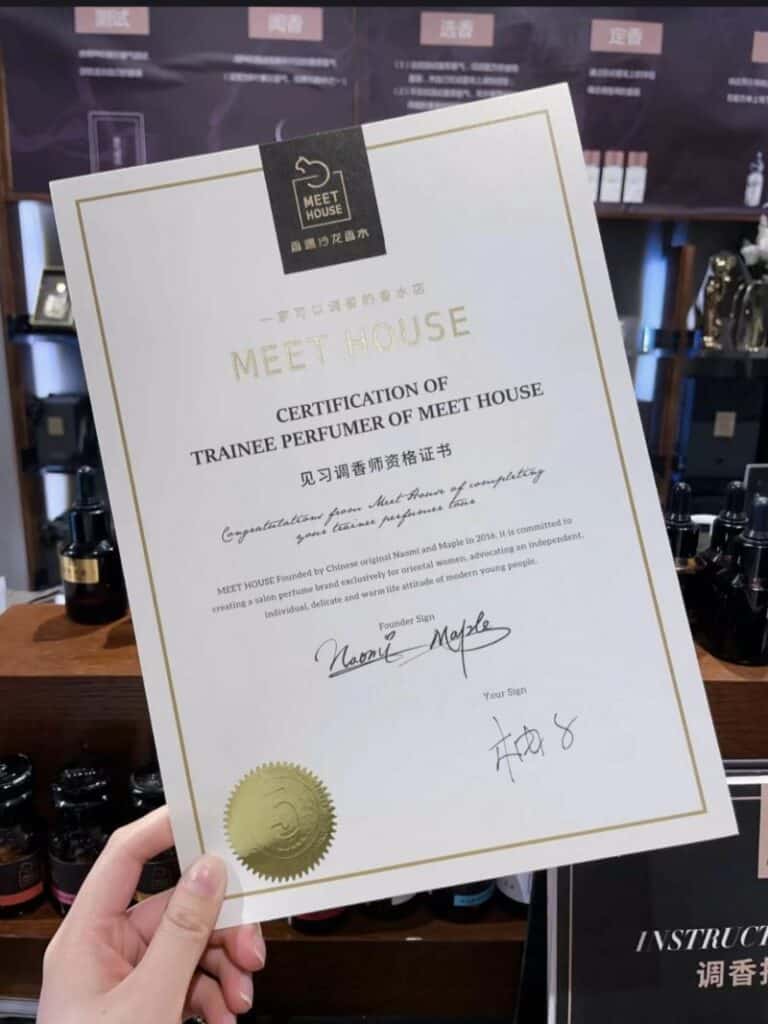Perfumes can be light and airy or bold and daring. But what are these complex scents made of?
Perfumes can be made of natural or synthetic ingredients, or a combination of the two – which is called semi-synthetic. The scent itself is derived from botanical essential oils, animal material, or artificial fragrance compounds based on smells we encounter in nature. But all perfumes incorporate some amount of water and alcohol to help carry the scent.
Additional solvents are also added to build up the fragrance and help it last a long time. To learn more about the complexities of perfume, continue reading.

What Exactly is in a Perfume?
Perfume manufacturers list some of their ingredients but I’ll state up front that we’ll never know exactly how any perfume has been made.
Companies have the right to keep the specifics of their fragrance formulas to themselves. This protects them from having their scent formulas stolen by other companies.
Consider these ingredients from the Dutch luxury brand, Viktor & Rolf. Flowerbomb is a warm and spicy floral perfume for women.

It’s unlikely that any trade secret ingredients were included on this list. You’ll notice, though, that alcohol, fragrance, and water are the top three ingredients. This is common across most modern day perfumes.
In ancient times, perfumes in their purest forms were made of oils, dried botanicals, resins and natural woods. Perfumes were minimally accessible and often only used during religious rituals.
Over time, technology has evolved perfume into an industry, making perfumes more accessible than ever. What was once an occasional indulgence or solely part of religious practice has become a daily use item.
Modern perfumery was spearheaded by the French. They still maintain the highest standard of fragrance manufacturing.
But as you may have experienced, scientists are able to recreate fragrances that are similar to the more popular and expensive brands. This way, more accessible brands can release replicated luxury scents that have become popular to the masses. Often, these duplicate fragrances are offered at a lower price point.
Perfume Ingredients
It takes a trained scientist or master perfumer to combine the right amount of ingredients and produce an attractive scent. While we’ll never know all of the ingredients used, below we cover the most common.
Alcohol
The primary ingredient in any perfume is going to be alcohol. There are many different types that can be used, but the most common type of alcohol used to make perfume is ethyl alcohol, also referred to as ethanol.
Ethyl alcohol helps carry the fragrance molecules so that they disperse properly. It’s a stable solvent that won’t compete with the aromatic ingredients because it’s largely odorless.
Read more: Why Add Whisky to Cologne
Water
Also a dispersal agent, distilled water will always comprise some portion of the fragrance formula.
Both alcohol and water are added in varying amounts, impacting the concentration of the perfume. For example, parfum has the most amount of fragrance, and therefore the least amount of water, because it’s less diluted.
Aromatic Sources
All fragrances are inspired by nature. Whether airy, floral, citrusy, woody, or so on, humans are drawn to scents found in the world around them. So you’ll find that plant and animal scents are dominant in perfumes.
Plant Sources
Fragrant aromas can be extracted from flower blossoms, roots, fruit peels, leaves, bark, herbs, and other plant matter. There are many different methods used to capture the essence of these scents. Steam distillation is a common method to extract most plant-based essential oils.
Some natural scents, like citrus oil, must be pressed in order to extract the fragrance, otherwise they’ll damage the source.
It’s also possible to extract a fragrance using solvents. Rose is often extracted this way because it’s too delicate for steam distillation. Since a solvent is used, the result is rose absolute, not rose essential oil.
Animal Sources
Believe it or not, some of your favorite fragrances might be made from the raw material of animals. Here are some examples:
- Musk (extracted from musk deer glands)
- Ambergris (sperm whale secretions)
- Hyraceum (petrified feces and urine excrement from the cape hyrax)
- Civet (a pasty substance from the glands of this small mammal)
Each of these scents might have a repulsive odor in their original states. Once diluted, though, they can offer a softer, more mellow layer of fragrance.
Synthetic Formulas
All or most of these natural aromatic sources can be replicated in a lab. Scientists can manufacture scents that are derived from natural sources, and then produce them on a mass scale.
Scientists can also produce scents that aren’t readily found in nature, like baby powder.
In some cases, manufacturers produce synthetic animal scents in order to adhere to certain social or moral beliefs. For instance, a vegan fragrance brand would synthetically produce musk in order to avoid mistreating the musk deer in any way.
Cost is another factor that determines whether an aromatic is derived from a natural source or produced in a lab. For instance, ambergris is fairly rare and definitely expensive, so it’s often produced synthetically in order to keep costs down for the consumer.
Additional Ingredients
Trace amounts of fixatives are usually added to the fragrance, water, and alcohol blend. The fixatives prevent the perfumes from evaporating too quickly. They also help stabilize the formula so that your perfume smells the same over an extended period of time. Fixatives can be natural or synthetic.

Do Perfumes Contain Harmful Chemicals?
It would be unfair to ignore the fact that perfumes can cause an adverse reaction in some individuals.
Perfume formulas contain volatile organic compounds (VOCs). These are fine particles that have been released into the air. Not all VOCS are harmful.
They exist all around us, whether we smell them in fragranced products or not. But some can cause irritation or lead to more serious illness through prolonged exposure.
VOCs found in some perfumes include: d-limonene, formaldehyde, benzyl alcohol, and acetone.
Volatile organic compounds can lead to immediate headaches for some people. Bouts of fatigue and nausea can be debilitating. Throat, eye, or nose irritation and difficulty breathing are also common reactions.
These reactions might be intensified or occur more rapidly when a person is exposed to certain perfumes while in small spaces. Being on a crowded elevator is a good example. Another example would be an office space with limited ventilation or little to no air circulation.
In extreme cases, VOCs can trigger an asthma attack. With prolonged exposure, they can cause illnesses like cirrhosis of the liver.
Irritation vs Allergic Reaction
You may not even know if you’ll experience irritation or an allergic reaction to perfume ingredients until you try on a new scent.
If those ingredients irritate your skin, you’ll likely see a rash form almost immediately.
Alternatively, if there’s an ingredient in the formula to which you already have an allergy, then you might not begin to experience allergy symptoms until days later.
Since allergies are a lifelong diagnosis, most people know which scents they may need to shy away from. But if you’ve never been exposed to that particular ingredient, then you won’t find out about the allergy until after there’s been skin contact.
But Don’t Be Alarmed
VOCs alone are not toxic, it’s their interaction with light and/or one another that causes some of them to become lethal.
Overall, if you spray on perfume in moderation, its ingredients are unlikely to cause long term damage to your health.
But if you find that you’re experiencing skin or respiratory irritation after spraying your favorite perfume, you might want to try one with a different combination of ingredients.
Since VOCs react with sunlight, it also helps to keep your perfume out of direct sunlight, and spray it on in a well ventilated area.
Perfumes Are Widely Used
Keep in mind that in addition to personal fragrances that are sprayed onto the body, perfumes are found in body wash, soap, air fresheners, cleaning products, hair products, and more.
Perfumes are complex formulas that can change the way we feel about ourselves and others. Learning what perfumes are made of can help you determine what role you want them to play in every facet of your life. I hope this article offered some clarification for you on this topic.
